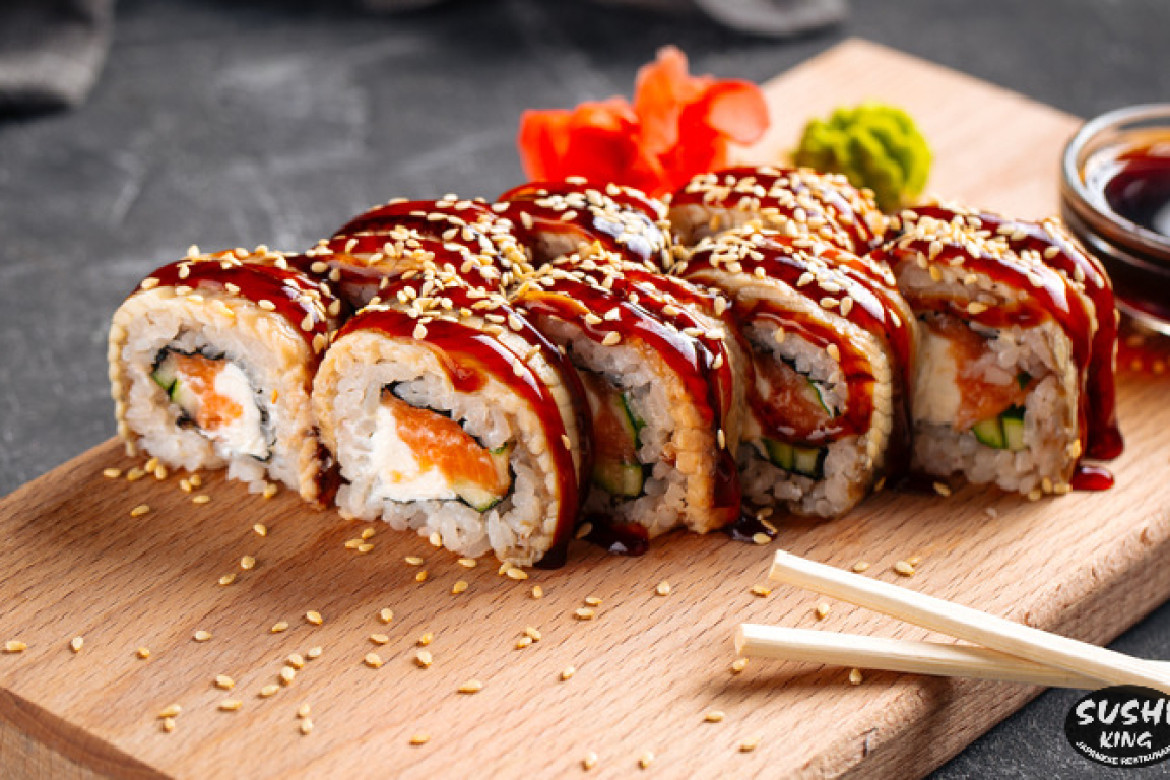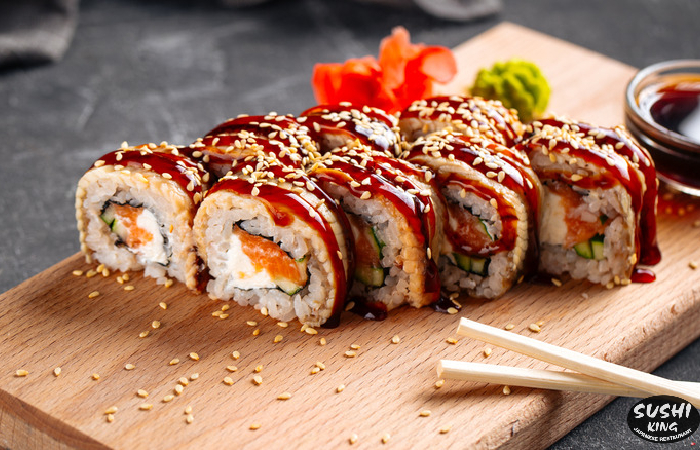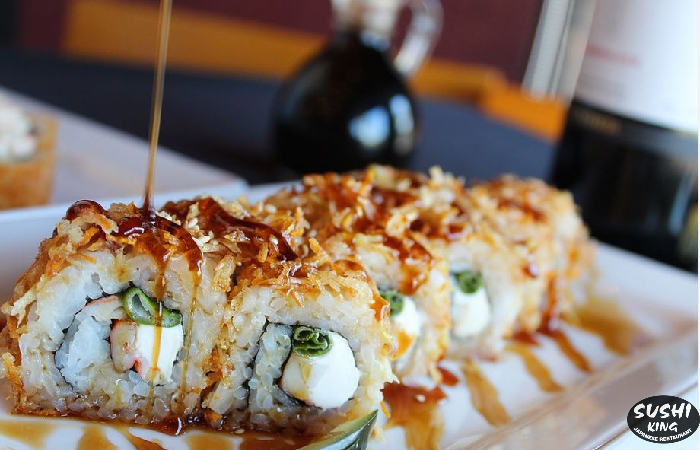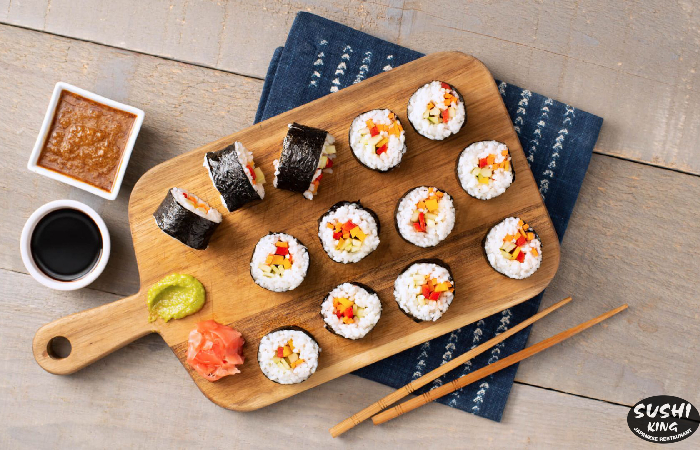
What Is The Brown Sauce On Sushi
Brown sushi sauce is incredibly versatile, as it can be used not only on sushi rolls but also in a variety of dishes. From stir-fries to marinades, this delectable sauce adds a unique and delicious Asian-inspired flavor to any meal.
What is Brown Sauce On Sushi (Eel Sauce)?
Brown Sauce On Sushi, also known as eel sauce or unagi sauce, is a delightful Asian-inspired condiment cherished for its sweet and savory flavors. Initially used to glaze grilled eel in traditional Japanese cuisine, it has gained popularity as a delectable topping for various sushi rolls. Its glossy texture and umami-rich taste have made it a favored choice for enhancing the flavors of sushi and an array of other dishes.
The Origin of Eel Sauce: Why is it called Eel Sauce?
Brown Sushi Sauce, or eel sauce, goes by various names such as unagi sauce or kabayaki sauce, originating from its traditional application as a glaze for grilled eel (unagi) dishes in Japanese cuisine. "Unagi" refers to freshwater eel, frequently prepared in the "kabayaki" style, where the eel is grilled and generously basted with a thick, sweet, and savory sauce.

This sauce, crafted from a blend of soy sauce, mirin, sugar, and sometimes sake, intensifies the flavors of grilled eel while giving it an appetizing, glossy appearance. Over time, this delectable sauce has evolved into a versatile condiment, often referred to as "eel sauce" or "brown sushi sauce," and is now embraced in various sushi dishes and other Japanese recipes.
Readmore: What is kirby in sushi?
Where to Find Brown Sushi Sauce (Eel Sauce)
Eel sauce can be conveniently sourced from a variety of retail outlets, including:
Asian markets: Specialized Asian grocery stores commonly offer a diverse selection of authentic Japanese condiments, including eel sauce. Look for trusted brands such as Kikkoman, Yamasa, or Otafuku in the sauce aisle.
Supermarkets: Larger supermarkets equipped with well-stocked international food sections may stock eel sauce alongside other Japanese culinary essentials. Check in proximity to soy sauce, teriyaki sauce, and other Asian condiments.
Online retailers: Websites like Amazon, Walmart, or dedicated online stores for Asian groceries provide accessible avenues for acquiring eel sauce, particularly if local Asian markets are not readily available.
Gourmet or specialty food stores: Certain gourmet food retailers or specialty shops focused on global cuisines may also feature eel sauce and other Japanese condiments in their inventory.
Always remember to scrutinize the label for ingredients and allergen information if you have specific dietary restrictions or preferences.
Ingredients for Brown Sauce On Sushi
To prepare brown sushi sauce at home, you will require the following ingredients:
Soy sauce or tamari: Serving as the base, soy sauce contributes umami flavor. Opt for low-sodium soy sauce for a milder saltiness or tamari for a gluten-free alternative.
Seasoned rice vinegar: Introduces tanginess while balancing the sauce's sweetness.
White wine or mirin: Enhances the sauce's complexity and depth of flavor. Mirin is a sweet Japanese rice wine, while dry white wines like pinot grigio or chardonnay can serve as suitable substitutes.
Sweetener: Maple syrup or agave nectar imparts sweetness to the sauce, creating a harmonious balance with the saltiness and acidity.
Cornstarch: As a thickening agent, cornstarch provides the sauce with a smooth, glossy consistency.
How to Make Brown Sauce On Sushi at Home
To create your homemade brown sushi sauce, follow these steps:
Gather all the ingredients, including soy sauce or tamari, seasoned rice vinegar, white wine or mirin, sweetener (maple syrup or agave), and cornstarch.
Measure the required amounts of each ingredient.
In a small saucepan, combine the soy sauce, rice vinegar, white wine, sweetener, and cornstarch.
Bring the mixture to a boil over medium-high heat, stirring frequently to prevent lumps from forming.
Once the sauce starts to thicken, reduce the heat and allow it to simmer for a few minutes.
Remove the saucepan from the heat and let the sauce cool.
Transfer the cooled sauce to an airtight container, such as a jar, bottle, or bowl, and store it in the refrigerator for up to two weeks.

Tips for Making and Customizing Brown Sushi Sauce
-
Stir the mixture continuously while cooking to ensure a smooth texture and prevent sticking or lumping.
-
Adjust the sauce's flavor to your liking by adding more sweetener for increased sweetness, more soy sauce for additional saltiness, or more rice vinegar for added tang.
-
To create a gluten-free version of the sauce, substitute gluten-free tamari for soy sauce.
-
If you prefer a spicier sauce, consider adding a pinch of red pepper flakes or a small amount of sriracha.
-
Experiment with various sweeteners, such as honey or brown sugar, to achieve your desired flavor. For a thicker consistency, add more cornstarch; to thin it out, use less cornstarch or add a small amount of water.
-
Enhance the sauce's flavor by incorporating minced garlic or ginger during the cooking process.
Eel Sauce Substitutes: Alternatives for a Similar Flavor
If eel sauce is unavailable or you prefer to make a homemade alternative, here are some substitutes that can provide a similar flavor profile:
Teriyaki sauce: A popular Japanese sauce made from soy sauce, mirin, and sugar, with a flavor akin to eel sauce.
Hoisin sauce: A Chinese sauce comprising soybeans, garlic, vinegar, and sugar, offering a sweet and savory flavor that works well as a substitute for eel sauce.
Oyster sauce: A rich, savory sauce crafted from oyster extract, soy sauce, and sugar, delivering a glossy texture and umami flavor akin to eel sauce.
Sweet soy sauce: A thick, sweet sauce derived from soy sauce and sugar, resembling eel sauce and often used as a marinade for meats and vegetables.
Homemade eel sauce: If you have soy sauce, mirin, sugar, and sake at your disposal, you can craft your own eel sauce by combining these ingredients in a saucepan and simmering until the sauce reaches a thick, glossy consistency.
Readmore: What is AYCE sushi?
Storage and Shelf Life of Brown Sushi Sauce
To ensure the longevity of your brown sushi sauce:
-
Allow the sauce to cool completely before transferring it to an airtight container, such as a jar, bottle, or bowl.
-
Store the sauce in the refrigerator to maintain freshness and prevent spoilage.
-
When stored appropriately, the brown sushi sauce should remain usable for up to two weeks.
-
If you detect any changes in the sauce's color, odor, or texture, discard it promptly, as it may no longer be safe for consumption.

Nutritional Information for Brown Sushi Sauce
Approximate per 1 oz serving:
- Calories: 23 Total
- Fat: 0 g
- Saturated: 0 g
- Fat: 0 g
- Trans Fat: 0 g
- Cholesterol: 0 mg
- Sodium: 538 mg
- Total Carbohydrates: 4 g
- Dietary Fiber: 0 g
- Sugars: 3 g
- Protein: 0 g
FAQs
Q: What Does Brown Sauce on Sushi Taste Like?
A: Brown sauce on sushi has a delightful combination of sweetness and umami. It is known for its rich, glossy texture and offers a sweet, savory, and slightly tangy flavor profile. The sauce complements the natural flavors of sushi ingredients.
Q: Where Can I Find Brown Sauce for Sushi?
A: You can find brown sauce for sushi at various locations, including Asian markets, larger supermarkets with international sections, online retailers like Amazon, gourmet or specialty food stores, and even some general grocery stores. Look in the sauce aisle or the Asian condiments section.
Q: How Long Does Homemade Brown Sauce for Sushi Last?
A: When stored in an airtight container in the refrigerator, homemade brown sauce for sushi should remain fresh for up to two weeks. Be sure to cool the sauce completely before refrigerating it.
Conclusion
In general, it cannot be denied that the brown sauce on sushi is an important part of what makes sushi so delicious. Sushi chefs are known for their creative use of soy sauce to elevate recipes and create unique flavor combinations. Brown sauce is a great way to add rich and delicious flavor to standard sushi dishes. While the exact recipe may vary, many basic variations include mirin, sugar, and sake. So why not try? Come to Sushi King to find out what's so special about the brown sauce on sushi!
